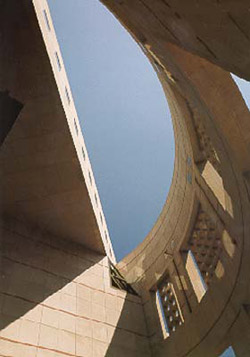 | The curved portal at the 14th Street entrance to the Museum. Jeff Goldberg/United States Holocaust Memorial Museum
|
Freed wants the visitor to experience the Museum building "viscerally." Just as the Holocaust defies understanding, the building is not meant to be intellectually understood. Its architecture of sensibility is intended to engage the visitor and stir the emotions, allow for horror and sadness, ultimately to disturb. As Freed says, “It must take you in its grip.”
 |
What Makes This Building Talk?
In the words of architect James Ingo Freed, the Museum's architecture is intended to be a "resonator of memory." Join Museum educators as they demonstrate how aspects of the building's structure reflect the history housed within its walls.

Please check at the Information Desk for dates and times.
|
 |
Congress authorized the United States Holocaust Memorial Museum in 1980 to be a permanent living memorial to all victims who perished in the Holocaust. The building has been designed as a living institution dedicated to research and teaching as well as to contemplation and commemoration.
The Museum building houses permanent and temporary exhibition spaces, a research library and archives, two theaters, an interactive computer learning center, classrooms, a memorial space, and areas for impromptu discussion.
|
Architect James Ingo Freed, of Pei Cobb Freed & Partners, created an architectural relationship between the Museum building and the exhibitions within. To inform his design, he visited a number of Holocaust sites, including camps and ghettos, to examine structures and materials. The result is not a neutral shell. Instead, the architecture, by a collection of abstract forms — invented and drawn from memory — refers to the history the Museum addresses.
Architectural allusions to the Holocaust are not specific. Visitors make their own interpretations. The subtle metaphors and symbolic reminiscences of history are vehicles for thought and introspection. In Freed's words, “There are no literal references to particular places or occurrences from the historic event. Instead, the architectural form is open-ended so the Museum becomes a resonator of memory.”
|
